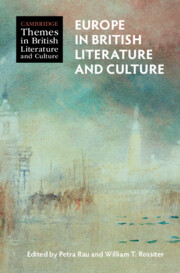Book contents
- Europe in British Literature and Culture
- Cambridge Themes in British Literature and Culture
- Europe in British Literature and Culture
- Copyright page
- Contents
- Illustrations
- Contributors
- General Editor’s Preface
- Acknowledgements
- Introduction
- Part I Zones of Influence
- Part II Pan-European Moods and Movements
- Chapter 7 Renaissance
- Chapter 8 The Enlightenment
- Chapter 9 Romanticism
- Chapter 10 The Gothic
- Chapter 11 Modernism
- Part III Cultural Transfers
- Part IV Anxious Neighbourhoods, Uncertain Futures
- Index
Chapter 7 - Renaissance
from Part II - Pan-European Moods and Movements
Published online by Cambridge University Press: 06 June 2024
- Europe in British Literature and Culture
- Cambridge Themes in British Literature and Culture
- Europe in British Literature and Culture
- Copyright page
- Contents
- Illustrations
- Contributors
- General Editor’s Preface
- Acknowledgements
- Introduction
- Part I Zones of Influence
- Part II Pan-European Moods and Movements
- Chapter 7 Renaissance
- Chapter 8 The Enlightenment
- Chapter 9 Romanticism
- Chapter 10 The Gothic
- Chapter 11 Modernism
- Part III Cultural Transfers
- Part IV Anxious Neighbourhoods, Uncertain Futures
- Index
Summary
In the later nineteenth century, British scholars were ambivalent about their nation’s state as part of Europe, but they were certain that it had participated in one of the staging-posts of European civilization’s history, the Renaissance. In the early modern period, something closer to the opposite was the case. Those earlier authors did not have recourse to the term ‘Renaissance’ and they talked more specifically of a revival of good letters, meaning being able to write Latin and Greek as the best ancient authors did; to those studies they also added knowledge of Hebrew. In Italy, this revival was sometimes seen as a local phenomenon, which they had to export to the rest of Europe, including far-off Britons. In England in the second quarter of the sixteenth century, John Leland constructed a different vision in which compatriots from the preceding hundred years were instrumental in the revival’s success. There were, then, competing models, one of centre and periphery, another of collaboration diffused across Europe. Both these models, however, came under extreme strain when faced with the divisions created by the Reformation.
Keywords
- Type
- Chapter
- Information
- Europe in British Literature and Culture , pp. 119 - 132Publisher: Cambridge University PressPrint publication year: 2024

